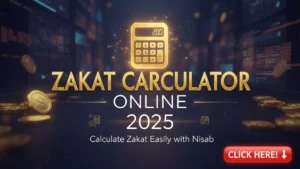⏳ Please wait 40 seconds…
Read the Article and do valuable comment on this post
1. Introduction
In 2025, the crypto market, while promising, is also a hotbed for sophisticated scams. From phishing to rug pulls, threats to your investments are constant. This article guides you, especially new investors, on identifying and avoiding these scams, protecting your funds and aligning with Islamic values. Understanding these red flags is crucial for safeguarding your financial future in digital assets.
2. Why Crypto Scams Are Still Growing in 2025
Crypto scams persist due to new, often uninformed investors, the ease of creating fake platforms, and lack of central oversight. Scammers now use advanced AI for convincing phishing and deepfakes, making detection harder. This constant evolution demands continuous vigilance.
3. 10 Red Flags to Watch For
Recognizing these red flags is crucial for protecting your crypto investments.
Red Flag 1: Guaranteed High Returns (Too Good to Be True)
What it is: Promises of unrealistic, fixed, or guaranteed returns.
Why it’s dangerous: Legitimate investments carry risk; guarantees are a scammer's lure.
How to spot it: Phrases like “guaranteed 1% daily.” If it sounds too good to be true, it is.
Red Flag 2: Unverified Team or Anonymous Founders
What it is: Project teams are anonymous or lack verifiable professional backgrounds.
Why it’s dangerous: Anonymity prevents accountability in case of fraud or rug pulls.
How to spot it: Check for verifiable identities, LinkedIn profiles, and past projects. Beware of stock photos.
Red Flag 3: Fake Partnerships or Misleading Whitepapers
What it is: False claims of partnerships or whitepapers with plagiarized content, vague details, or unrealistic roadmaps.
Why it’s dangerous: Creates a false sense of legitimacy, manipulating investors.
How to spot it: Verify partnerships directly. For whitepapers, look for clarity, detailed technicals, and realistic plans.
Red Flag 4: No Liquidity Lock / Rug Pull Risk
What it is: Developers don’t lock liquidity on DEXs, allowing them to withdraw funds and crash the token price.
Why it’s dangerous: This is a classic rug pull, leading to total loss for investors.
How to spot it: Check if liquidity is locked using blockchain explorers or tools like TokenSniffer/RugDoc. No lock or a very short lock is a major red flag.
Red Flag 5: Pressure Tactics Like “Limited Time Offer”
What it is: Scammers create false urgency with phrases like “last chance” to rush investment decisions.
Why it’s dangerous: Urgency bypasses rational thought, leading to rushed, uninformed decisions. Scammers exploit FOMO.
How to spot it: Be suspicious of any investment demanding immediate action. Legitimate opportunities allow time for research.
Red Flag 6: No Clear Business Model or Revenue Stream
What it is: A project lacking a defined business model, value proposition, or plausible revenue generation.
Why it’s dangerous: Legitimate projects need sustainable economic models. Vague plans often indicate a Ponzi scheme.
How to spot it: Look for detailed plans on technology, target market, user acquisition, and revenue. Be cautious if answers are vague.
Red Flag 7: Heavily Promoted by Random Influencers
What it is: Project gains traction primarily through aggressive promotion by social media influencers, often without disclosure of paid endorsements.
Why it’s dangerous: Can lead to pump-and-dump schemes where price is artificially inflated, then crashes when insiders sell.
How to spot it: Observe marketing. Is it organic growth or sponsored posts? Check for disclosure. Beware of overly aggressive, hype-driven promotion.
Red Flag 8: Lack of Third-Party Audits
What it is: Projects, especially with smart contracts, not audited by reputable firms, or reports are not public/verified.
Why it’s dangerous: Smart contracts are immutable; vulnerabilities can lead to fund loss. Lack of audit indicates negligence.
How to spot it: Legitimate projects display audit reports from well-known firms (e.g., CertiK). Verify authenticity.
Red Flag 9: Unregulated Platforms with No Customer Support
What it is: Crypto platforms operating without proper regulatory oversight and offering little to no accessible customer support.
Why it’s dangerous: No regulatory protection means no recourse in case of fraud. Lack of support leaves you stranded.
How to spot it: Check for registration/licensing. Look for clear terms and multiple support channels. Be suspicious of generic contact forms.
Red Flag 10: No Real Community or Fake Social Media Engagement
What it is: A project lacking a genuine, active community, or whose social media presence is artificially inflated.
Why it’s dangerous: A strong community indicates health. Fake engagement suggests deception and a struggling project.
How to spot it: Look beyond follower counts. Check quality of engagement: thoughtful comments vs. repetitive. Beware of massive followers with little interaction.
Also Read:- CryptoHalal: Are Cryptocurrencies Halal or Haram? A Complete Islamic Guide 2025
4. Halal Investing Reminder
For Muslim investors, ensuring crypto investments align with Islamic finance principles is crucial. This means avoiding haram (forbidden) elements like gambling, interest (riba), and excessive uncertainty (gharar).
Verifying Halal Compliance:
- Underlying Activity: Project’s core business must be permissible (no gambling, interest-based lending).
- Gharar (Uncertainty): Avoid projects with vague models or pure speculation.
- Riba (Interest): No projects generating returns primarily through interest.
- Ethical Funds: Project funds must not be invested in haram activities.
What makes a project Haram:
- Gambling: Direct involvement in games of chance.
- Riba: Direct involvement in charging or paying interest.
- Gharar: Speculative bubbles with no underlying value.
- Forbidden Industries: Projects supporting haram industries.
Thorough due diligence for Muslim investors includes ethical and religious compliance. Prioritize faith-compliant investments.
5. Tools to Stay Safe in Crypto (Mini Guide)
Equip yourself with these tools and practices for crypto safety:
TokenSniffer
What it is: Automated tool analyzing smart contracts for scam patterns and vulnerabilities.
How to use it: Paste a token’s contract address for a report on suspicious activities.
Why it’s useful: Provides a quick security assessment for new tokens.
RugDoc
What it is: Community-driven platform reviewing DeFi projects, focusing on rug pulls and scams.
How to use it: Check their website for project reviews and risk levels.
Why it’s useful: Catches nuances automated tools might miss, invaluable for DeFi safety.
CoinMarketCap Alerts
What it is: Price alerts and watchlist features to monitor cryptocurrency performance.
How to use it: Set custom price alerts for significant drops, signaling potential malicious activity.
Why it’s useful: Helps you react quickly to sudden price changes.
How to DYOR (Do Your Own Research)
What it is: Comprehensive, independent investigation of a crypto project.
Key aspects of DYOR:
- Whitepaper: Understand vision, technology, tokenomics, roadmap.
- Team: Research founders’ experience and public presence.
- Community: Observe social media engagement for genuineness.
- Code: Review smart contract code and audits (if technical).
- Tokenomics: Understand distribution, supply, vesting.
- Use Case: Does it solve a real problem? Competitive edge?
- Partnerships: Verify claims directly.
- Regulation: Understand the project’s legal environment.
Why it’s useful: Empowers informed decisions, reduces reliance on biased sources. Your diligence is your best defense.
6. FAQs
What’s the most common crypto scam in 2025?
Sophisticated phishing attacks and rug pulls remain dominant. Phishing uses AI-generated fake sites to steal private keys. Rug pulls involve developers abandoning projects and withdrawing liquidity, leaving investors with worthless tokens.
Is DeFi safe now?
DeFi has matured but carries risks. Smart contract vulnerabilities and exploits can occur. For Muslim investors, riba and gharar considerations are vital. DeFi is safer, but not risk-free; it demands technical understanding and vigilance.
Are Muslim investors more vulnerable to certain scams?
Not inherently, but they face unique challenges. Scammers exploit the desire for halal investments by falsely claiming Sharia compliance, subtly incorporating haram elements. Lack of accessible Sharia-compliant screening tools can make due diligence harder.
Can staking be a scam?
Staking is legitimate, but the underlying project or platform can be fraudulent. Scam projects offer unsustainable high rewards to attract investors, then rug pull. Staking on unregulated platforms also poses risks. Always verify the project and platform’s legitimacy.
7. Conclusion
The crypto market offers immense opportunity but also significant peril from scams. In 2025, sophisticated scams demand unwavering vigilance. The ten red flags discussed are crucial tools for financial self-defense.
For all investors, especially those adhering to halal principles, crypto navigation requires both financial prudence and ethical integrity. Prioritize transparent teams, clear business models, robust audits, and genuine utility. Embrace “Do Your Own Research” (DYOR) as your primary shield. True wealth is built on sustainable foundations, not fleeting promises.
Ultimately, your judgment is your strongest safeguard. If an offer feels wrong, or demands immediate, unthinking action, it’s likely a scam. Stay vigilant, educated, and choose verified, halal opportunities. Your financial security depends on discerning the genuine from the fraudulent, ensuring investments align with your values.







1 thought on “How to Avoid Crypto Scams in 2025: 10 Red Flags Every Investor Should Know”